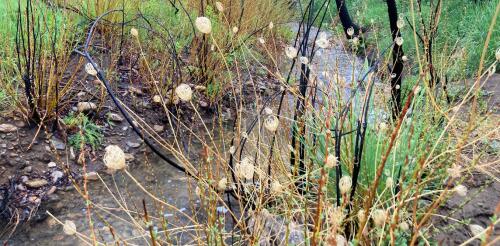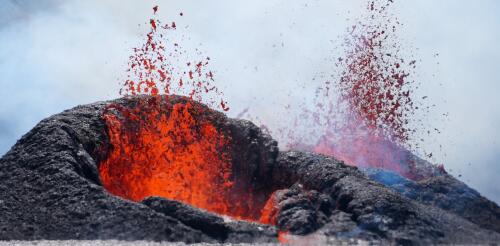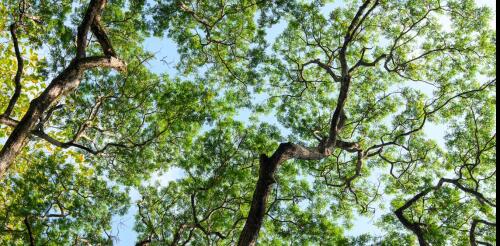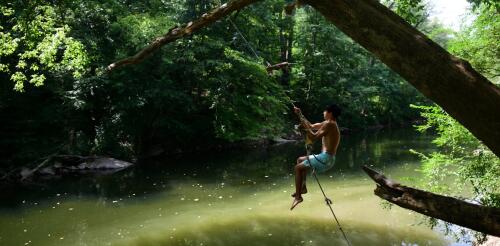environment
A tiny, vibrant world thrives along the rocky bottom of most streams. As sunlight filters through the water, mayfly nymphs, no larger than your fingernail, cling to algae-coated cobbles. Their brushlike mouthparts scrape the greenish coating, leaving faint trails as they feed. Six spindly legs anchor them against the current, while feathery gills wave gently, drawing oxygen from the flowing water. This scene is common in well-maintained creeks and streams that flow through populated areas. But when wildfires sweep through, the toxic materials left behind can devastate this ecosystem. When you think of urban wildfires, you might picture charred trees and houses. But beneath the surface of nearby streams, fires can also cause a silent upheaval – one that affects populations of creatures that are important indicators of the water’s health. Images of some of the benthic invertebrates that help keep streams healthy, and whose disa...
Curious Kids is a series for children of all ages. If you have a question you’d like an expert to answer, send it to curiouskidsus@theconversation.com. Could we use volcanoes to make electricity? – Lawrence, age 7, Dublin, California Turning red-hot lava from an active volcano into electricity would be dangerous and unreliable. Volcanoes don’t erupt on predictable schedules, and lava cools too quickly. But many countries, including the U.S., have found ways to tap volcanic heat to make electricity. Geothermal energy comes from heat generated by natural processes deep within the Earth. In most areas, this heat only warms rocks and underground water near the surface. In volcanically active regions, however, the heat is much more intense. Sometimes it melts rock, forming magma. Volcanoes act like giant heat vents, raising magma closer to Earth’s surface. Some of this mo...
As intense heat breaks records around the world, a little-reported fact offers some hope for cooling down cities: Under even the most intense periods of extreme heat, some city blocks never experience heat wave temperatures. How is this possible? Civilizations have recognized the power of cities to heat themselves up and cool themselves for centuries. City architects in ancient Rome called for narrowing streets to lessen late afternoon temperatures. Narrow streets were found to cool the air by limiting the area exposed to direct sunlight. The whitewashed architecture of the Greek Isles demonstrates another long-practiced strategy. Light-colored walls and roofs can help cool cities by reflecting incoming sunlight. Whitewashed buildings on the Greek island of Folegandros help deflect the heat rather than absorbing it. Etienne O. Dallaire via Wikimedia, CC BY In hot and humid regions of the southern...
When you walk through a forest, it may feel like a static setting where very little is happening. But trees are constantly interacting and reacting to each other as they grow. There’s intense competition for light and space. Every shift affects the overall makeup of the forest in some way. Forest scientists like me spend a lot of time thinking about forest succession – a predictable process in which plant species colonize and dominate a piece of land. The basic sequence is for land to evolve from an open field to brush and shrubs, then to young trees and ultimately to large, mature trees. Disturbances, such as a major storm or wildfire, can interrupt or set back forest succession. I study ecological changes in species composition, tree arrangement and forest development that occur during succession and after disturbances. My research team analyzes conditions in mixed-species deciduous, or leafy, forests. Using tree rings, we reconstruct what previous forests looked l...
Spanning 2,000 acres with more than 50 miles of trails, Wissahickon Valley Park in northwest Philadelphia offers a variety of recreational opportunities, from hiking and biking to bird watching and picnicking. We are a professor of history who co-authored a book on the Wissahickon Valley and an assistant professor of biology. We teach students at Chestnut Hill College, which sits directly across the street from this lush urban park, about the environmental history of the Wissahickon forest and the importance of preserving its biodiversity. We’re also developing a documentary on the Wissahickon funded by the Sisters of Saint Joseph. We want our students – and all Philadelphians – to understand the importance of protecting this urban ecosystem as a way to build climate resilience. Like many of the country’s other great urban parks – from Central Park in New York or Rock Creek Park in Washington to the smaller Phalen Park in St. Paul, Minnesota R...




